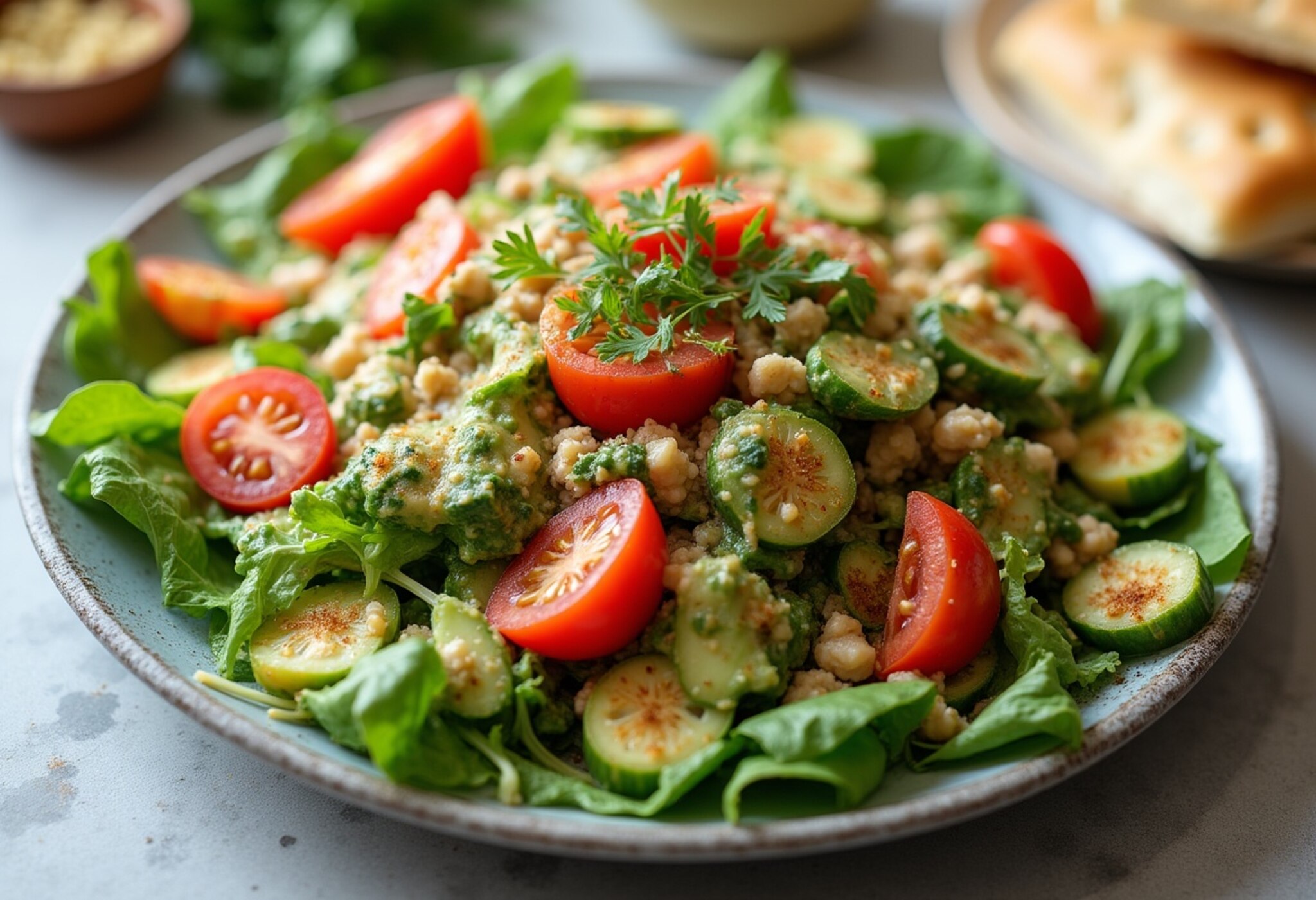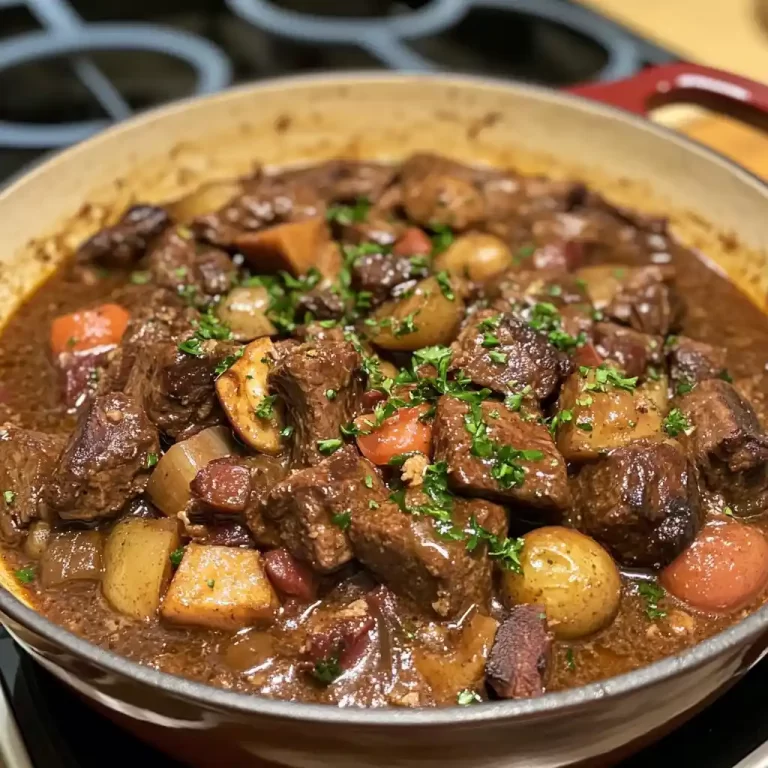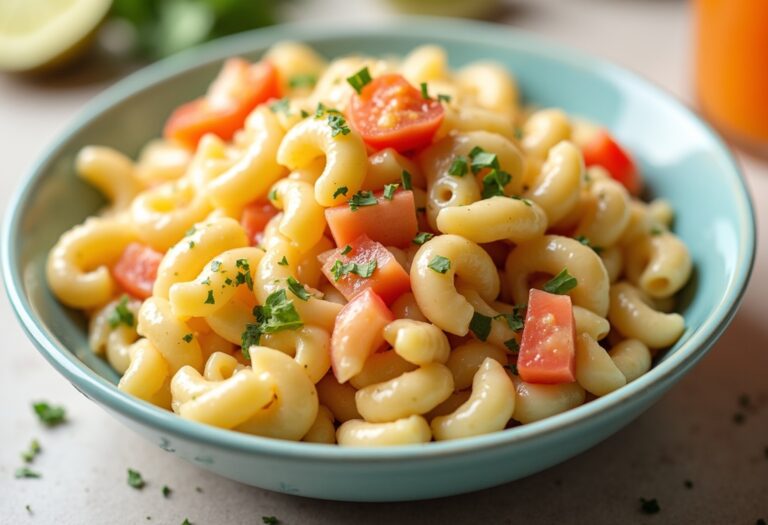Fatoush Salad Recipe

Fatoush salad, a beloved Middle Eastern dish, has captured the hearts and taste buds of food enthusiasts around the world. This vibrant and refreshing salad is a celebration of bold flavors, crisp textures, and the rich culinary traditions of the Levant region.
Originating from the Levantine countries, fatoush salad has become a staple in many households and restaurants, praised for its ability to transport diners on a flavorful journey through the Middle East. With its unique blend of fresh greens, tangy dressing, and crunchy pita chips, this salad is a delightful and versatile addition to any meal.
❤️ Why You’ll Love This Recipe ❓
Fatoush salad is a true delight for the senses. The combination of fresh, crunchy vegetables, tangy lemon-garlic dressing, and toasted pita chips creates a harmonious blend of textures and flavors that will leave you craving more. What sets this recipe apart is the perfect balance between the sharp, lemony notes and the subtle sweetness of the vegetables, all tied together by the satisfying crunch of the pita.
Beyond its exceptional taste, fatoush salad is also a nutritious and accessible option. Most of the ingredients are readily available in your local grocery store or pantry, making it a convenient and budget-friendly choice for busy weeknights or weekend gatherings. Plus, with the ability to easily adapt the recipe to accommodate dietary preferences, it’s a crowd-pleasing dish that can be enjoyed by all.
🛒 What You Need to Prepare Fatoush Salad ❓
• 1 cup cherry tomatoes, halved
• 1 cucumber, diced
• 1 red onion, thinly sliced
• 1 cup fresh parsley, chopped
• 1 cup fresh mint, chopped
• 2 pita breads, torn into bite-sized pieces
• 2 tablespoons olive oil
• 2 tablespoons lemon juice
• 1 garlic clove, minced
• 1 teaspoon sumac (optional)
• Salt and pepper to taste
The beauty of this fatoush salad is that most ingredients are pantry or freezer staples. The combination of fresh greens, crisp vegetables, and tangy-herbal flavors creates the Middle Eastern-inspired profile that has made fatoush salad a perennially popular dish.
📝 How to Make Fatoush Salad Step-by-Step ❓
• Step 2: In a small bowl, whisk together the olive oil, lemon juice, minced garlic, and sumac (if using). Season with salt and pepper to taste.
• Step 3: Add the torn pita bread pieces to the salad and toss gently to combine.
• Step 4: Drizzle the lemon-garlic dressing over the salad and toss again to ensure all the ingredients are evenly coated.
• Step 5: Serve the fatoush salad immediately, while the pita bread is still crunchy.
⏱️ Timing Overview
• Cooking time: 0 minutes
• Total time: 15 minutes
Compared to traditional Middle Eastern salads that can take up to 30 minutes to prepare, this fatoush salad saves you 50% of your cooking time while delivering similar fresh and vibrant flavors.
👩🏻⚕️ Nutritional Information
Per serving (based on 4 servings):
• Protein: 5g
• Carbohydrates: 20g
• Fat: 8g
• Fiber: 5g
• Sodium: 300mg
These fatoush salads provide approximately 20% of your daily vitamin C requirements and 15% of your daily fiber needs, making them not just delicious but nutritionally valuable as well.
🔄 Healthier Alternatives for the Recipe
• Lower-carb version: Replace the pita bread with low-carb options like zucchini noodles or cauliflower rice.
• Dairy-free adaptation: Omit the yogurt and use a plant-based milk or lemon juice to create the dressing.
• Added protein: Top the salad with grilled chicken, chickpeas, or feta cheese for an extra protein boost.
• Boost vegetables: Add diced bell peppers, shredded carrots, or radishes for more nutrient-dense veggies.
These modifications can reduce calories by up to 20% or adapt the recipe for specific dietary needs without compromising the fundamental flavor profile of the fatoush salad.
🍽️ Serving Suggestions
• Pair it with a warm pita bread or flatbread for a complete and satisfying vegetarian meal.
• Complement the salad with a creamy hummus or baba ghanoush for a Mediterranean-inspired feast.
• For a light lunch, serve the fatoush salad on its own or alongside a bowl of lentil soup or chicken noodle soup.
• Create a vibrant and colorful platter by arranging the fatoush salad alongside other Middle Eastern favorites like tabbouleh, baba ghanoush, and stuffed grape leaves.
❌ Common Mistakes to Avoid
• Using too much dressing: The fatoush salad dressing should lightly coat the ingredients, not drown them. Start with a small amount of dressing and toss gently, adding more as needed to achieve the desired flavor and texture.
• Skipping the sumac: Sumac, a tangy and earthy spice, is a key ingredient in traditional fatoush salad. While it can be omitted, it adds a unique flavor profile that enhances the overall dish.
• Letting the salad sit too long: The pita chips will become soggy if the salad sits for too long. Serve the fatoush immediately after tossing to maintain the perfect crunch.
• Forgetting to balance the flavors: Ensure the salad has a good balance of tangy, herbal, and slightly sweet notes by adjusting the lemon juice, garlic, and salt to your taste preferences.
🧊 Storing Tips for the Recipe
These fatoush salads retain their quality remarkably well:
• Freezing unbaked: The salad ingredients (excluding the pita bread) can be frozen for up to 2 months. Thaw in the refrigerator overnight before assembling and serving the salad.
• Freezing baked: Leftover fatoush salad can be frozen for up to 1 month. Allow the salad to cool completely, then transfer it to an airtight container or freezer-safe bag. Reheat in the oven at 350°F (175°C) for 10-15 minutes to restore the crispness of the pita bread.
• Reheating: For best results, reheat the fatoush salad in the oven at 350°F (175°C) for 5-10 minutes, or until the pita bread is crisp again. Avoid microwaving, as it can make the pita soggy.
❓ FAQs
Can I make the fatoush salad ahead of time?
Yes, you can prepare the fatoush salad in advance. Store the chopped salad ingredients and the dressing separately in the refrigerator for up to 3 days. Toss the salad with the dressing just before serving to maintain the crispness of the pita bread.
Can I substitute the pita bread with something else?
Absolutely! While pita bread is the traditional choice, you can use other types of crispy breads or crackers as a substitute. Toasted whole-wheat or gluten-free bread, croutons, or even crushed tortilla chips can work well in place of the pita bread.
Is the fatoush salad suitable for dietary restrictions?
Yes, the fatoush salad can be easily adapted to accommodate various dietary needs. For a dairy-free version, replace the yogurt in the dressing with plant-based milk or lemon juice. To make it lower in carbs, swap the pita bread for low-carb alternatives like zucchini noodles or cauliflower rice. The salad can also be made vegan by omitting the cheese or meat toppings.
What if my pita bread gets soggy?
If the pita bread in the fatoush salad becomes soggy, you can try to restore its crispness by toasting the pieces in a dry skillet or oven for a few minutes until they regain their crunchy texture. Be sure to toss the salad with the dressing just before serving to prevent the pita from absorbing too much moisture.
Can I add other ingredients to the fatoush salad?
Absolutely! The fatoush salad is highly versatile, and you can easily customize it by adding your favorite ingredients. Some tasty additions could include diced bell peppers, shredded carrots, crumbled feta cheese, or even grilled chicken or chickpeas for extra protein.
Conclusion
These fatoush salads represent the perfect balance of convenience, flavor, and presentation. Whether you’re serving them as a refreshing side dish or a light main course, they’re sure to impress with their vibrant colors, crunchy textures, and bold Middle Eastern-inspired flavors. The versatility of this recipe allows for countless variations to suit your taste preferences and dietary needs.
With simple ingredients and straightforward preparation, these fatoush salads demonstrate that sophisticated flavors don’t require complicated techniques – just quality ingredients and a little bit of care in the assembly. So, gather your freshest produce, toast some pita, and get ready to embark on a delightful culinary journey through the flavors of the Levant.
Fatoush salad is a true celebration of the vibrant and diverse culinary traditions of the Middle East. By bringing this dish into your kitchen, you’ll not only enjoy a refreshing and nourishing meal but also connect with the rich cultural heritage that has made it a beloved classic. So, what are you waiting for? Give this fatoush salad recipe a try and discover the joy of this timeless Middle Eastern delight.
Print
Fatoush Salad Recipe
- Total Time: 15 minutes
Ingredients
• 1 head romaine lettuce, chopped
• 1 cup cherry tomatoes, halved
• 1 cucumber, diced
• 1 red onion, thinly sliced
• 1 cup fresh parsley, chopped
• 1 cup fresh mint, chopped
• 2 pita breads, torn into bite-sized pieces
• 2 tablespoons olive oil
• 2 tablespoons lemon juice
• 1 garlic clove, minced
• 1 teaspoon sumac (optional)
• Salt and pepper to taste
Instructions
• Step 1: In a large salad bowl, combine the chopped romaine lettuce, halved cherry tomatoes, diced cucumber, thinly sliced red onion, chopped parsley, and chopped mint.
• Step 2: In a small bowl, whisk together the olive oil, lemon juice, minced garlic, and sumac (if using). Season with salt and pepper to taste.
• Step 3: Add the torn pita bread pieces to the salad and toss gently to combine.
• Step 4: Drizzle the lemon-garlic dressing over the salad and toss again to ensure all the ingredients are evenly coated.
• Step 5: Serve the fatoush salad immediately, while the pita bread is still crunchy.
- Prep Time: 15 minutes
- Cook Time: 0 minutes
- Category: Dinner
- Cuisine: Americans
Keywords: Fatoush Salad Recipe






